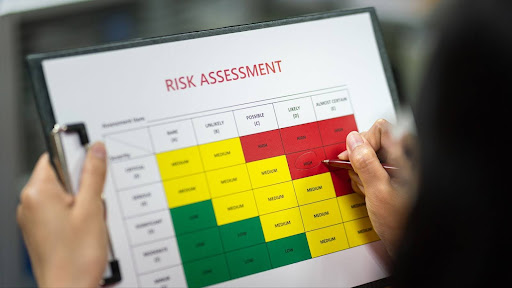Vendor Risk Management
- Vendor Risk Management
- What is Third Party Vendor Risk Management (VRM)?
- Common Types of Vendor Risks
- Why is Vendor Risk Management Important?
- What is a Vendor Risk Strategy?
- What Does a Risk Management Framework Include?
- What are Vendor Risk Management Workflows?
- How to Manage Vendor Risks
- What About Fourth-Party Vendor Risk Management?
- Challenges in a Vendor Risk Management Program
- Other Vendor Risk Management Considerations
- How EntityCheck Helps You Manage Vendor Risk

Small startups to global corporations all deal with risk. There are different levels of risk and many causes. Most companies need to work with vendors for supplies and services. These vendors can expose your company to enormous risk and even ruin your company. The key is understanding vendor risk management and collecting tools for mitigating and avoiding risk. Below, we discuss what vendor risk management is, the common types to watch out for, and some vendor risk management solutions, including the right vendor risk management tool that can help keep your business safe.
What is Third Party Vendor Risk Management (VRM)?
Business risk covers a wide range of possible dangers. Vendor risk management (VRM) is a specific process for ensuring that the companies that you work with don't cause your business harm. A good vendor risk management program identifies, assesses, and mitigates vendor risk when using third-party suppliers or other services. It means taking a hard look at any vendors or partners to ensure their business practices don't expose your business, operations, finances, or reputation to risk. By implementing strong third-party vendor risk management strategies, businesses can better protect themselves from external threats.
Most companies rely on third-party products or services, putting them at risk. The larger issue is that connecting with these vendors could compromise your network's security or create compliance issues for your company, leading to government sanctions.
Common Types of Vendor Risks
The vendor risk management life cycle includes onboarding, the life of the entire partnership, and even offboarding when you terminate the relationship. Some common types of vendor risks include the following:
Why is Vendor Risk Management Important?
As companies rely more heavily on third-party vendors, vendor risk management becomes a crucial aspect of business. Some of the finer details about why vendor risk management is so important are:
What is a Vendor Risk Strategy?
A vendor risk management system is a structured approach (strategy) to identifying, assessing, and mitigating vendor risk. The strategy contains components that begin with sourcing and end with the termination of the third-party vendor.
A clear vendor risk management strategy helps companies stay on track, protect sensitive data, ensure regulatory compliance, avoid costly and legal issues, maintain a good reputation, and avoid operational delays.
What Does a Risk Management Framework Include?
Although your company's third-party vendor risk management framework may vary slightly, most businesses will share the same core components. They are as follows:
What are Vendor Risk Management Workflows?
Vendor risk management workflows are the structured policies, procedures, and plans you use to identify, assess, and mitigate risks associated with working with third parties. A workflow is like the blueprint you work off when performing vendor risk management tasks. A typical workflow may look something like this:
- Vendor Selection/Onboarding: Find and review possible candidates and identify those you want to work with.
- Due Diligence: Conduct due diligence researching and assessing their financial stability, cybersecurity posture, and compliance history.
- Draft a Contract: Draft a clear, detailed contract before beginning work with the vendor.
- Risk Assessment: Perform a detailed risk assessment of the potential downsides of working with a particular vendor, paying close attention to your reliance on them and how it might affect your operations.
- Risk Mitigation: Develop a vendor risk management policy and mitigation steps to avoid potential risks or quickly respond to them if they occur.
- Ongoing Monitoring: Create a plan or use automation to monitor the vendor's performance, reliability, and other factors on an ongoing basis.
- Vendor Performance: Develop specific key performance indicators (KPIs) to monitor the vendor's performance and alert you if something changes.
- Vendor Termination: At the end of the contract or when you change vendors, have a clear-cut process for offboarding the vendor, have them transfer all of your company data back to you, and formally terminate the contract.
Although these tasks can be performed manually, some may be improved using vendor risk management software. Automating vendor risk management removes the human equation from the process, improving your accuracy, speed, and efficiency. You can choose from many vendor risk management platforms to automate the process.
The benefits of an effective vendor risk management workflow are:
How to Manage Vendor Risks
Managing vendor risks is a process specific to each industry. For example, healthcare vendor risk management will primarily focus on patient data privacy and safety. In contrast, IT vendor risk management focuses more on the security aspects of the business (software, networking, hardware, etc.). Regardless of the industry or type of business, you have four main options for dealing with risk. They are as follows:
The option(s) you choose will be specific to your risk threshold and strategic goals. Risk management is an ongoing process that you may change over time.
What About Fourth-Party Vendor Risk Management?
Remember to consider fourth-party vendor risk while building your vendor risk management procedure. These companies are connected to or affiliated with your third-party vendors or partners. Even though they are once removed, these connections can still affect you. A good example would be a supplier who uses a specific web hosting company to house all its data. If that web host is insecure and your vendor has your customer data stored on its website, it could more easily be breached, and you would suffer because of it.
Along with vetting your third-party partners, check out the companies they use for business services.
Challenges in a Vendor Risk Management Program
When building a risk management program, you may encounter various challenges. The process itself is complex and requires careful planning. Below are some of the more common challenges your business may face when building a vendor risk management program.
Other Vendor Risk Management Considerations
During your remediation phase, you will want to report everything you learned about the risks and how you responded so you can avoid them in the future. Some questions to ask yourself are:
How EntityCheck Helps You Manage Vendor Risk

A successful vendor risk management plan relies on people, policies, practices, and technology. Top-notch vendor risk management tools can help your risk identification and mitigation programs succeed. EntityCheck is a team of data professionals who gather, collate, and report information on businesses across the U.S. Using our specialized software for vendor risk management, you can run business background checks looking for any red flags and filling in the blanks of your vendor risk management profile. We collect our information from government, public, and private sources, and you can access everything you need from one easy-to-use dashboard.
The information you can find in an EntityCheck business background report includes the following:
Secretary of State Filings
The Secretary of State is the state repository for business filings, including Articles of Incorporation, annual reports, changes in ownership, and business entity type designations. An EntityCheck report can show all that information.
UCC Filings
UCC filings, or UCC-1 filings, are public notices filed with the Secretary of State that declare a creditor has a legal claim on assets. UCC filings help establish priority for payouts if the debtor files for bankruptcy or experiences other financial difficulties. These filings are used for various assets like equipment, vehicles, inventory, accounts receivable, and real estate. EntityCheck provides you with the following information on UCC filings:
Professional Licenses
Many industries, like real estate, dentistry, nursing, teaching, hairdressers, appraisers, electricians, etc., require professional licenses before doing business. Individuals must undergo the proper training and testing before earning these licenses. Professional licenses are credentials that verify a specific skill or level of knowledge in the chosen field. Governments issue these permits or licenses after the person has passed the final exam and paid the fee. These licenses let the public know that the individual or business is qualified to perform the services required and meet government standards. EntityCheck license information will show:
Court Records
Many court records are public and readily available for review. They contain a wealth of information about people, companies, and any related legal issues. You can generally find information on lawsuits against the company, bankruptcies, liens, judgments, and federal dockets, which can fill in many blanks about a business or its owners. Some of the court record information you will find with EntityCheck includes:
Trademarks
A trademark is a legally protected sign, word, phrase, design, or symbol owned by a specific brand or product. It differentiates it from all others, prevents unfair competition, and ensures consumer protection. The purpose is so that consumers can quickly and easily identify a brand through its products or services. Trademarks protect intellectual property so that no one can duplicate them without permission. A few trademark examples are the Nike "swoosh," the phrase "Just Do It," and Coca-Cola. A trademark can even be a specific color or sound. EntityCheck provides the following information on trademarks:
Employees, Agents, and Officers
A company is built on the people who own and run it. Finding out all you can about a company's officers, employees, and agents can help you determine whether or not the business is viable and worth partnering with. Since KYB is centered on company beneficiaries, this section is critical. Some of the employees/agents/officers' information you can find with EntityCheck includes:
Patents
A patent is a government-granted legal right to an invention. A patent protects the invention from anyone else producing it, selling it, or using it for a period of "usually" 20 years. Patents are forms of intellectual property granting the holder exclusivity over their invention. Patents protect investments and protect products from being copied. EntityCheck provides the following information about patents:
Enjoy unlimited searches when you try EntityCheck business background reports. We offer a 7-day FREE trial for users.
- Vendor Risk Management
- What is Third Party Vendor Risk Management (VRM)?
- Common Types of Vendor Risks
- Why is Vendor Risk Management Important?
- What is a Vendor Risk Strategy?
- What Does a Risk Management Framework Include?
- What are Vendor Risk Management Workflows?
- How to Manage Vendor Risks
- What About Fourth-Party Vendor Risk Management?
- Challenges in a Vendor Risk Management Program
- Other Vendor Risk Management Considerations
- How EntityCheck Helps You Manage Vendor Risk